
Dilsea californica
California Red Blade, Leathery strap seaweed
9 May 2024
Tonquin Beach, Templar Channel, Vancouver Island, B.C., Canada
Tide: 0.2 feet at 08:29 PDT (measured at Tofino Tidal Station)
Weather: Clear, wind variable 0-5 km/hour, sea smooth, very low southwesterly swell, humidity 75%, 11 ˚C.
Moon: Waxing Crescent (3.1%, 2 days); Next Phase, First Quarter, 15 May 2024 at 4:48am pm PDT; Previous Phase, New Moon, 7 May 2024 at 8:21 pm PDT.
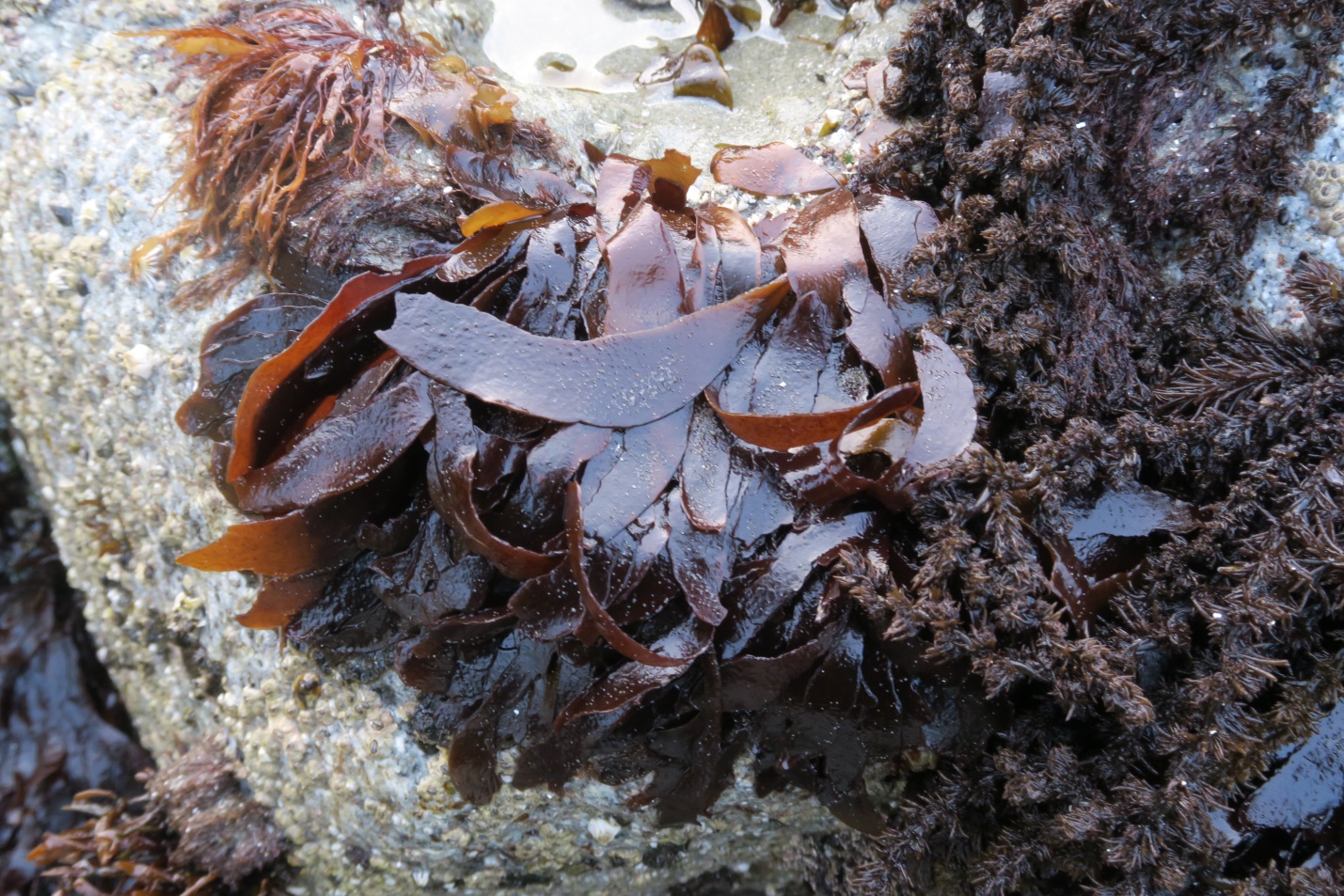
Figure 1: Some young sickle shaped blades of California Red Blade, Dilsea californica, are pictured here growing on a mid-intertidal rock alongside Neorhodomela larix and Prionitis sternbergii. Also known as “Leathery Strap Seaweed”, they do have a leathery look and texture and the seaweed is almost always deeply cleft into ‘straps’ such as is seen here. May 8, 2024. Tonquin Beach, Templar Channel, Vancouver Island, BC, Canada. Photo ID 27679 ©Seaweedwhisperings.com
Person 1:
Independent.
Flat.
Frayed edges.
Uninspiring.
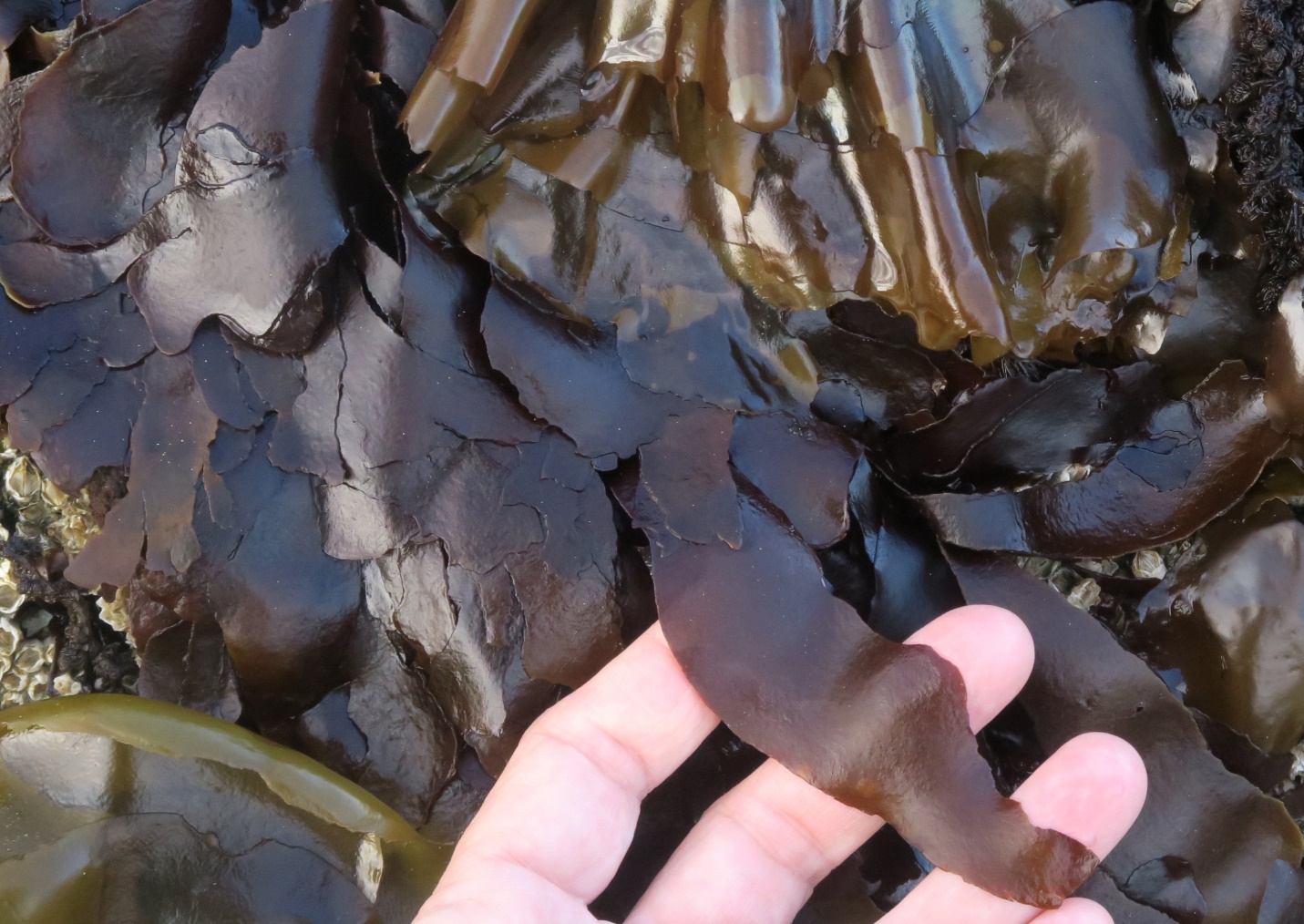
Figure 2: One Leathery Strap Seaweed section is held in hand to show relative size. While no two are ever quite alike, the blades of this seaweed often end up in a recognizable curved sickle shape. May 8, 2024. Tonquin Beach, Templar Channel, Vancouver Island, BC, Canada. Photo ID 27680 ©Seaweedwhisperings.com
Person 2:
Blades are quite thick and somewhat leathery in texture.
You are a dark brown color with strong undertones of red – maroon is one word that fits the color but a maroon with brown tinges more than purple. Blades are opaque.
It seems that a single blade often ‘tears’ lengthwise and this creates multiple long straps that tend to curve in a gentle sickle form. And the margins all along the blade edges are not at all smooth, it’s like chips have been broken off your edges in many, many places.
A dull knife?
A battle scarred sword?
The look is of many blades, a numerous collection of blades and they lie flatly layered atop each other, but since your margins are all so uneven, and you have a stiffness and thickness to you, the grouping is not a tidy one. Instead it appears as if something “has happened” to the individual blades – while looking similar they all have some differences to each other and they also seem to have suffered “injuries”.
You seem to enjoy places where you can be growing from rock that gives you a rather horizontal position – that is when the tide is out and no water is present to lift your blades from their holdfasts. Do you find reason or need to lie down and rest? What is it that you engage in that has you so ‘flattened’ at times?
You do look rather “battered and beaten” and somewhat “worn”, certainly at your margins; not as if you’ve lost your vitality, but rather more like your physical look reveals that you live a life of not stepping down from your struggles. You meet challenges, and you may be injured in the process but that doesn’t cause you to give up.

Figure 3: California Red Blade is looking quite maroon red in color here; the collection of thick blades has a matte or dull finish that contrasts with many other seaweeds. May 8, 2024. Tonquin Beach, Templar Channel, Vancouver Island, BC, Canada. Photo ID 27681 ©Seaweedwhisperings.com
Next Immersion:
Person 1:
Frayed edged ribbons – reminds me of the streamer decorations I’ve seen in Mexican villages, ones that were put for some long past festivity and since have weathered and faded. It also reminds me of the clusters of narrow leather straps called a riding crops or horse whips – the multi-fronded ones.
This seaweed energy may be battered and beaten, but it may also batter and beat. Perhaps it is defensive and fights but often picks up battle scars in the effort.
It doesn’t step down or away from a battle.
It seems this seaweed can be very energetic but also then needs to flatten and rest.
It feels somehow that this seaweed places a priority on work – get your work done first and at any cost.
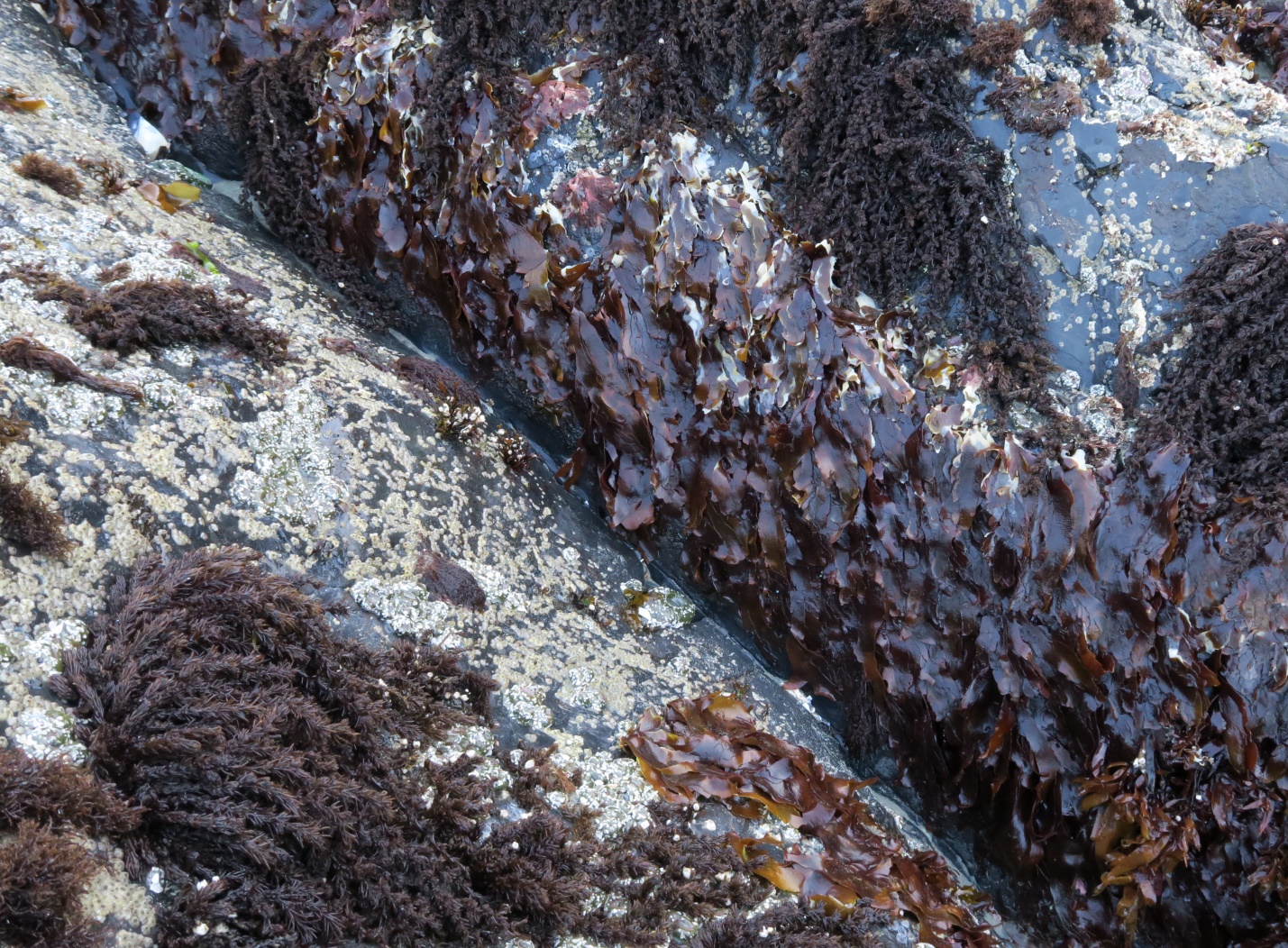
Figure 4: Pictured here is a crevice in the bedrock at mid-intertidal level. At the foreground on the left side and completely coating the rock on the right side of the crevice are a profusion of Dilsea californica thalli. The blades at the highest points of the rock are bleached to an off-white color – this is damage due to exposure at low tide. Blades lower down on the rock have escaped such damage. May 7, 2024. Tonquin Beach, Templar Channel, Vancouver Island, BC, Canada. Photo ID 27682 ©Seaweedwhisperings.com
Person 2:
“Opaque” – there are few seaweeds that I can think of that are quite this opaque. It is like there is no way to see into them. And you can’t see through them either; their visage does not reveal their motivations or agenda – their actions, however may give more of a clue to their inner nature.
This opaque nature of theirs, is that a protection? Or a consequence of toughening up by the deliberate action of becoming more “dense”? Dense as in, impenetrable and heavy and murky and NOT as in, stupid or unintelligent or slow. However..., when I thought about this last comment I see that there may be some degree of ‘stupidity’ involved in whatever it is that they persist in doing that seems to continue to scar and batter them.
It seems that they can be resistant to learning and adapting and changing their methods and that they can perhaps stay too long with their impulsive / knee jerk / instinctive way of responding to challenges.
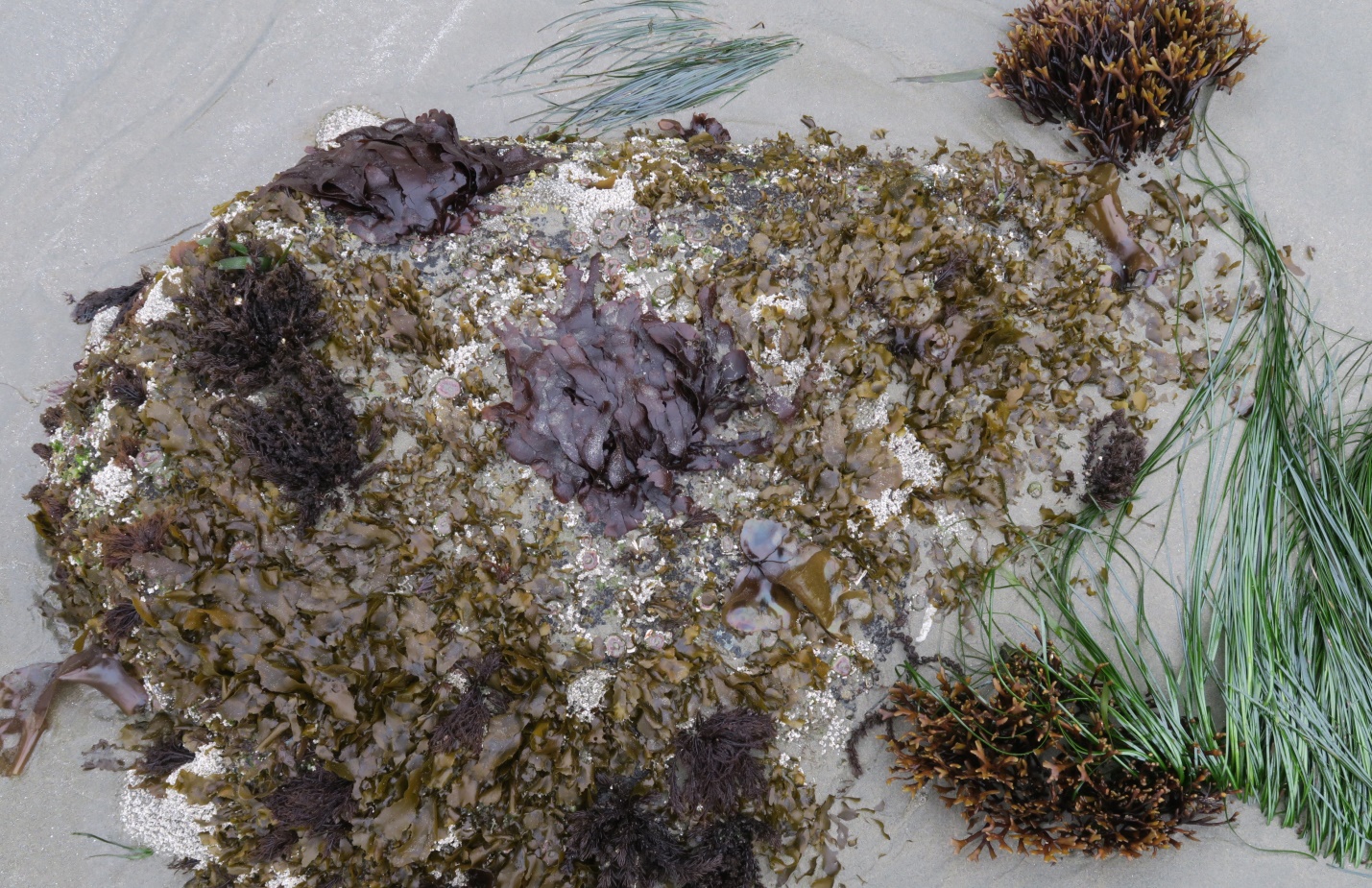
Figure 5: This photograph shows an entire sand buried boulder at Tonquin Beach. It is the ideal habitat for several sand scour and sand burial tolerant species of marine macro algae including: the Flat-tipped Forked Seaweed, Ahnfeltiopsis linearis (top right and bottom right); the smallish olive brown green bladed seaweed that covers most of the rock top, Phaeostrophion irregulare; and in the middle of the boulder and dipping over the top left of it is our species of interest – the dark reddish blades of Dilsea californica. Bright green sea grass and deep chocolate brown Neorhodomela larix are the two other prominent intertidal species in the photo. May 6, 2023. Tonquin Beach, Templar Channel, Vancouver Island, BC, Canada. Photo ID 27683 ©Seaweedwhisperings.com
Discussion:
Layered, and piled upon each other, sometimes their determination to get their work done, at any cost – leaves them exhausted and with no possibility to continue without at least some rest and revitalization. It feels like they rarely choose this rest but that at times it is almost forced upon them due to exhaustion, injury or illness.
Frayed and worn, but determined. VERY determined.
We found ourselves feeling curious about what’s at the base (of them), but you can’t see through the opaqueness and the multi protective layers to that base.
Uninspiring – this impression came about as the energy of this seaweed is so fully absorbed in its tasks that it’s not really relating well to anyone or anything else. The highly determined nature they have contributes to this idea others can pick up about them being uninspiring. It is evident that while Dilsea is fully committed to their goals, theirs is and intensive and costly-looking pursuit that few others are inspired by.
Fully absorbed in their tasks..., this is like their opaque physical trait – dark, thick and opaque means they swallow and absorb all the light coming in to them, and they don’t reflect much back. It must take a dedicated and determined worker to handle whatever amount of light that comes to them; do they need to store extra reserves for some later time, we wondered? Being seasonally buried in sand would of course stop any access to light, and so maybe good reserves are needed for the intervals when they are once again set free from the confines of their wet and heavy sandy prison to recommence their work.
There must be resilience to endure periods of sand burial, when their activities come to a full stop – or certainly any visible evidence ceases. We wondered how patient Dilsea would be with such delays and felt that they would need to dig deep within to find patience. Their preference is to stay on the job, to keep at it, until it is done. Maybe the sand burial is their salvation, as it imposes a time of rest when they won’t choose one for themselves.
When seen in groupings with other macroalgae, this seaweed provides the contrast, the flat, matte, darker background that ‘relieves the eye’ as compared to the showy colors of the iridescent Mazzaella splendens or the intricate lacy look of Ptilota filicina or the complicated spiral branching of Neorhodomela larix. One can actually take a break and NOT look at Dilsea and this can be restful, a true positive for others.
Dilsea californica does not scream out, “look at me!” Instead, the interesting aspects of Dilsea californica are mainly hidden – and that is how they like it.
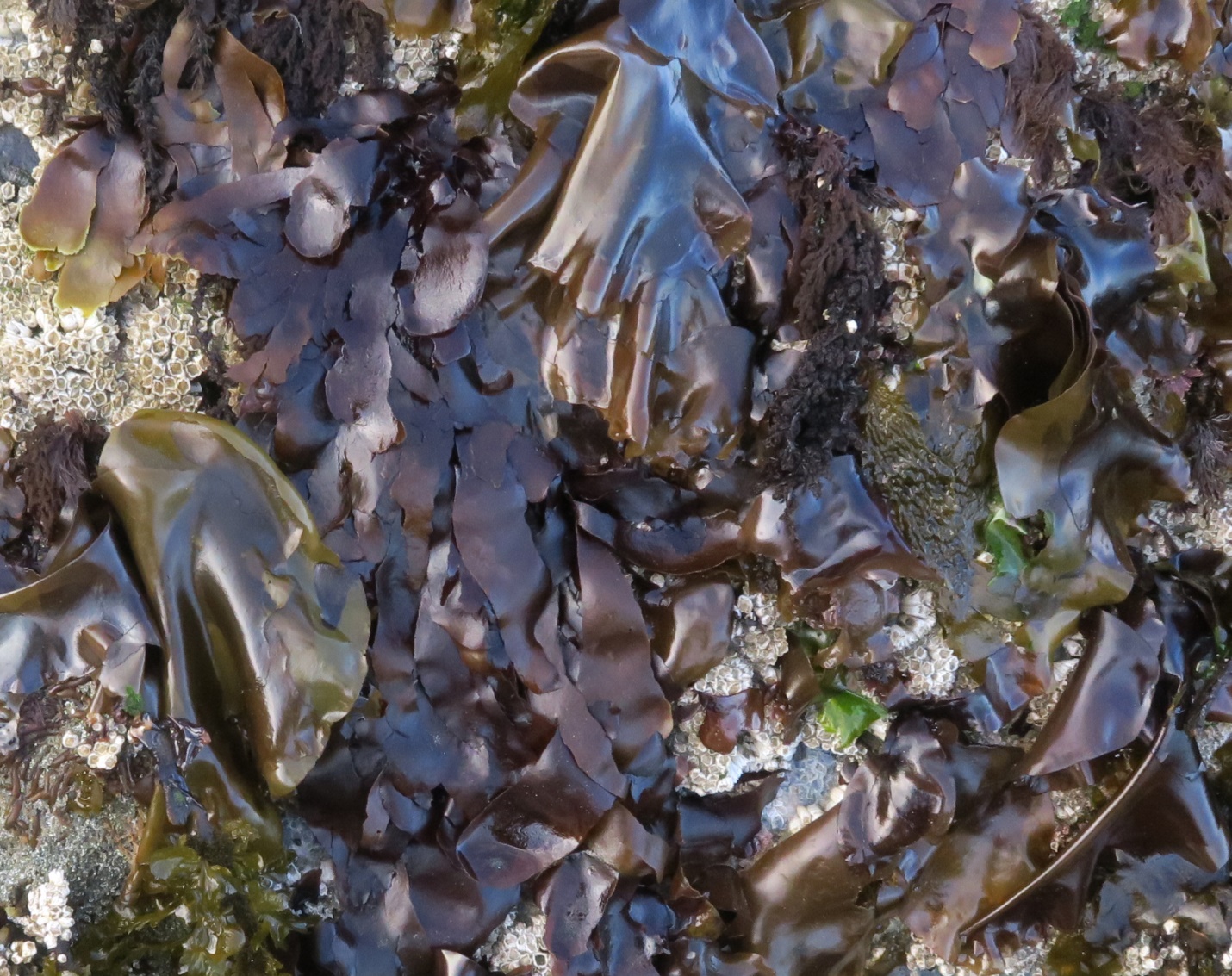
Figure 6: Draping down one side of a large sand-embedded boulder are many species of marine macro algae. The smooth iridescent brown-blue blades are Mazzaella splendens, and the flat, irregularly shaped deep reddish brown straps are Dilsea californica. Most of the Leather Strap Seaweed here is in prime form but on the upper left corner you can see how the blades sometimes turn a yellowish tan – this usually occurs later in summer. May 8, 2024. Tonquin Beach, Templar Channel, Vancouver Island, BC, Canada. Photo ID 27684 ©Seaweedwhisperings.com
Biology & Natural History Information:
Description:
The thallus is a maroon to brownish red blade that grows to 30 cm tall though often is shorter. California Red Blade forms a single erect blade, or clusters of blades, that are unbranched and lacks midribs or veins. Often the “single blade” is deeply cleft into curved or sickle-shaped pieces, giving the appearance of numerous blades. The blade has a thick, almost leathery texture and is not especially slippery. Unlike many red algae, this seaweed is not elastic. Dilsea californica has a slightly muted, dull finish and is not at all transparent.
Habitat:
On rocks, in the low intertidal and upper subtidal.
Distribution:
Aleutian Islands, Alaska to San Luis Obispo County, California.
Remarks:
This species has been reported to be one of the hosts for the rare endophytic green alga Ulvella ramosa; this green endophyte lives in the outer cortex and epidermis of certain several red algae species.
Classification:
Phylum: Rhodophyta
Class: Florideophyceae
Order: Gigartinales
Family: Dumontiaceae
Genus: Dilsea
Species: Dilsea californica (J.Agardh) Kuntze 1891
Other Name(s) & Synonyms:
Homotypic synonym; Sarcophyllis californica J.Agardh 1876
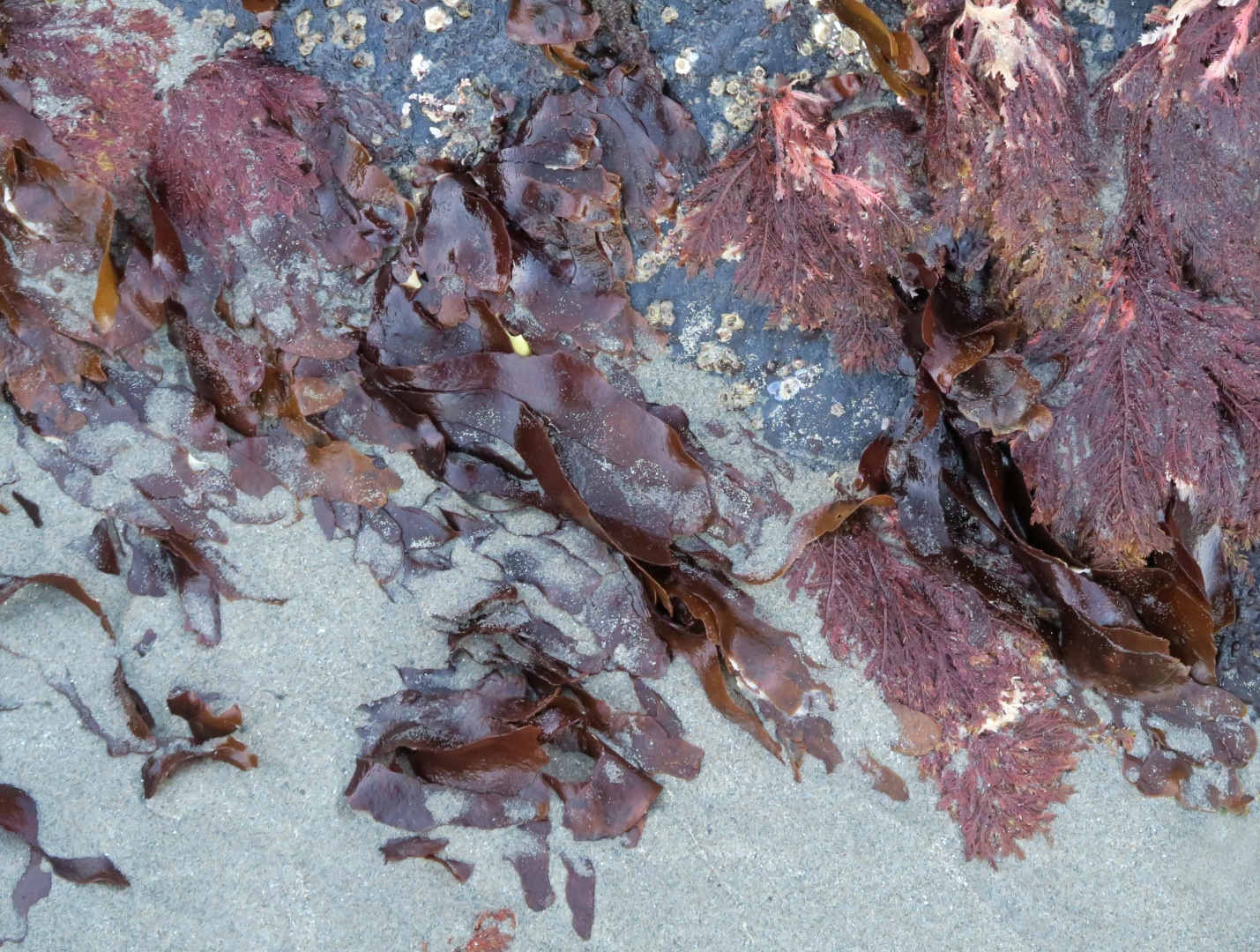
Figure 7: Partially buried in sand, Dilsea californica is viewed growing here adjacent to the lacy red algae, Ptilota filicina. Seaweeds adapted to seasonal sand burial have a remarkable type of resilience. May 7, 2024. Tonquin Beach, Templar Channel, Vancouver Island, BC, Canada. Photo ID 27685 ©Seaweedwhisperings.com
![]()